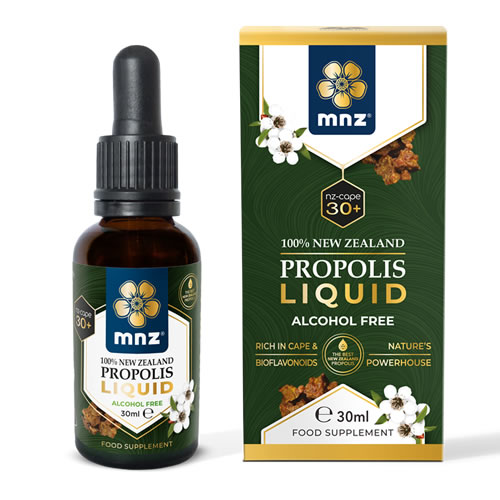Propolis is a natural product collected by bees from the resins of trees and plants. Bees mix these resins with wax and enzymes to create a sticky substance they use to protect their hive. The word “propolis” comes from Greek and literally means “before the city” — a reference to its protective function within the beehive.
Propolis is known for its rich composition. More than 300 natural compounds have been identified so far, including flavonoids, phenolic acids, aromatic acids, essential oils, minerals, and vitamins. This complex combination gives propolis its unique character.
A special feature of New Zealand propolis is its exceptionally high content of CAPE (Caffeic Acid Phenethyl Ester). This compound is internationally recognised as an important marker of propolis quality. The high CAPE level, together with the diversity of flavonoids and other bioactive compounds, makes New Zealand propolis distinctive compared to propolis from other regions.
The botanical source of the resin largely determines the profile of propolis. In New Zealand, bees gather mainly from poplars and native flora, creating characteristic chemotypes with a CAPE-rich signature. This regional origin also explains why batches can differ: landscape, season, and available plants all play a crucial role.

How do bees make propolis?
Bees collect resin from buds and bark of trees such as poplar, birch, chestnut, and various native species. Back in the hive they mix this with beeswax and enzymes from their saliva. The result is a sticky material used to seal cracks, strengthen hive walls, and protect against intruders. For bees, propolis is both a construction material and a vital defence system.
Beekeepers harvest propolis with special propolis mats or grids that encourage bees to fill openings. The harvested propolis is then purified and, depending on the final product, extracted with ethanol or vegetable glycerine. This process allows targeted standardisation for composition (e.g., CAPE) and purity.
Colour, taste and texture
The colour of propolis ranges from yellow-brown to dark brown or almost black, depending on flora and season. Its texture is sticky when warm, hard and brittle when cold. Propolis has a strong resinous scent and a powerful taste, often described as spicy and slightly bitter. These characteristics directly reflect the complex mix of resins and plant compounds from which propolis is formed.
What makes New Zealand propolis special?
- An exceptionally high CAPE content (Caffeic Acid Phenethyl Ester), internationally recognised as a marker for certain propolis profiles.
- Rich flavonoid diversity (including quercetin, pinocembrin, galangin) and phenolic compounds that define its chemical profile.
- A unique plant signature shaped by New Zealand’s indigenous flora and local growing conditions not found anywhere else in the world.
Because plant communities, altitude, rainfall, and climate vary by region, transparency about origin and batch characteristics is essential. This explains the international appreciation for New Zealand propolis with CAPE standardisation and traceable supply chains.

